
Kingfisher Wetlands Wildlife Lookout
Extra Info
Title: https://author.gardensbythebay.com.sg/editor.html/content/gbb-2021/sg/en/things-to-do/calendar-of-events.html
URL Source: https://www.gardensbythebay.com.sg/kingfisherwetlands
Markdown Content:
Kingfisher Wetlands
===============
Closure of Floral Fantasy on 1 - 5 Sep 2025
Closure of Cloud Forest on 1 Sep 2025
Closure of Flower Dome on 2 Sep 2025
1/3
Closure of Floral Fantasy on 1 - 5 Sep 2025
Floral Fantasy will be closed on 1 - 5 Sep 2025 for maintenance.
Closure of Cloud Forest on 1 Sep 2025
Cloud Forest will be closed on 1 Sep 2025 for maintenance.
Closure of Flower Dome on 2 Sep 2025
Flower Dome will be closed on 2 Sep 2025 for maintenance.
- Our Gardens Story###### Our Gardens Story Our StoryOur HistorySustainability Efforts
- Things to do###### Things to do Flower DomeCloud ForestFloral FantasyOCBC SkywaySupertree ObservatoryView all Attractions Garden PodArt SculpturesCalendar of EventsDine & Shop
- Plan your visit###### Plan your visit Opening Hours & ClosuresGetting Here & ParkingItinerary PlannerGardens Map Amenities & ServicesInformation GuidesVisiting GuidelinesMobile Apps & Travel Guide
- Learn with us###### Learn with us For SchoolsPre-SchoolPrimary SchoolSecondary SchoolGreen GuardiansSchool EngagementLearning Activities Explore ResourcesWhat's BloomingArticlesCrafts & WorksheetsComicsE-books VideosPlant DoctorDigital Photo Exhibition
- Our Gardens Story Back ###### Our Gardens StoryOur StoryOur HistorySustainability Efforts
- Things to do Back ###### Things to doFlower DomeCloud ForestFloral FantasyOCBC SkywaySupertree ObservatoryView all AttractionsGarden PodArt SculpturesCalendar of EventsDine & Shop
- Plan your visit Back ###### Plan your visitOpening Hours & ClosuresGetting Here & ParkingItinerary PlannerGardens MapAmenities & ServicesInformation GuidesVisiting GuidelinesMobile Apps & Travel Guide
Learn with us Back ###### Learn with usFor SchoolsPre-SchoolPrimary SchoolSecondary SchoolGreen GuardiansSchool EngagementLearning ActivitiesExplore ResourcesWhat's BloomingArticlesCrafts & WorksheetsComicsE-booksVideosPlant DoctorDigital Photo Exhibition
- View Promotions
- eShop
- Book a Venue
- Support Us
How can we help you?
![]()
Popular searches
- Floral Fantasy
- Supertrees
- Flower Dome
- OCBC Skyway
KingfisherWetlands
Previous
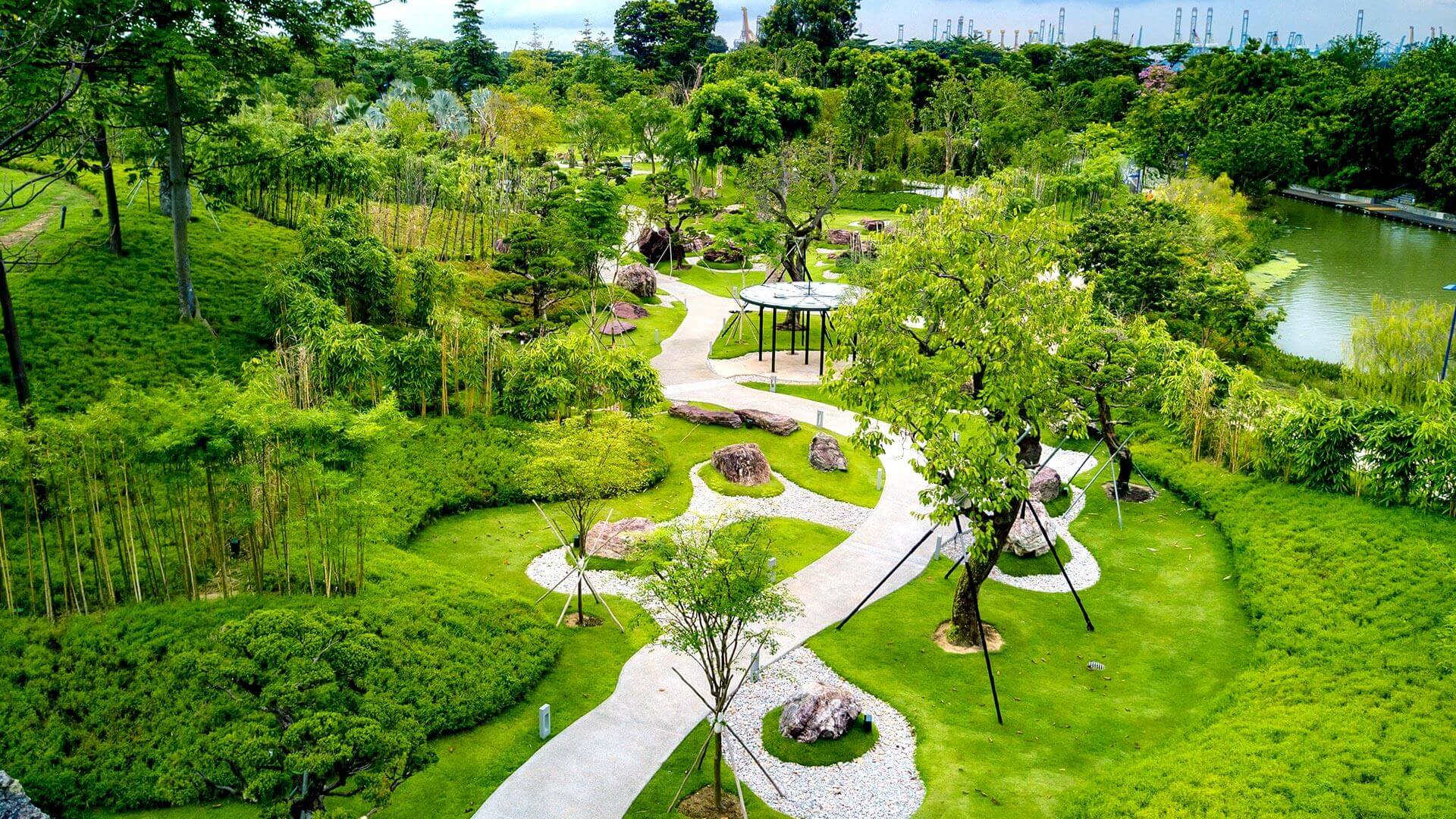
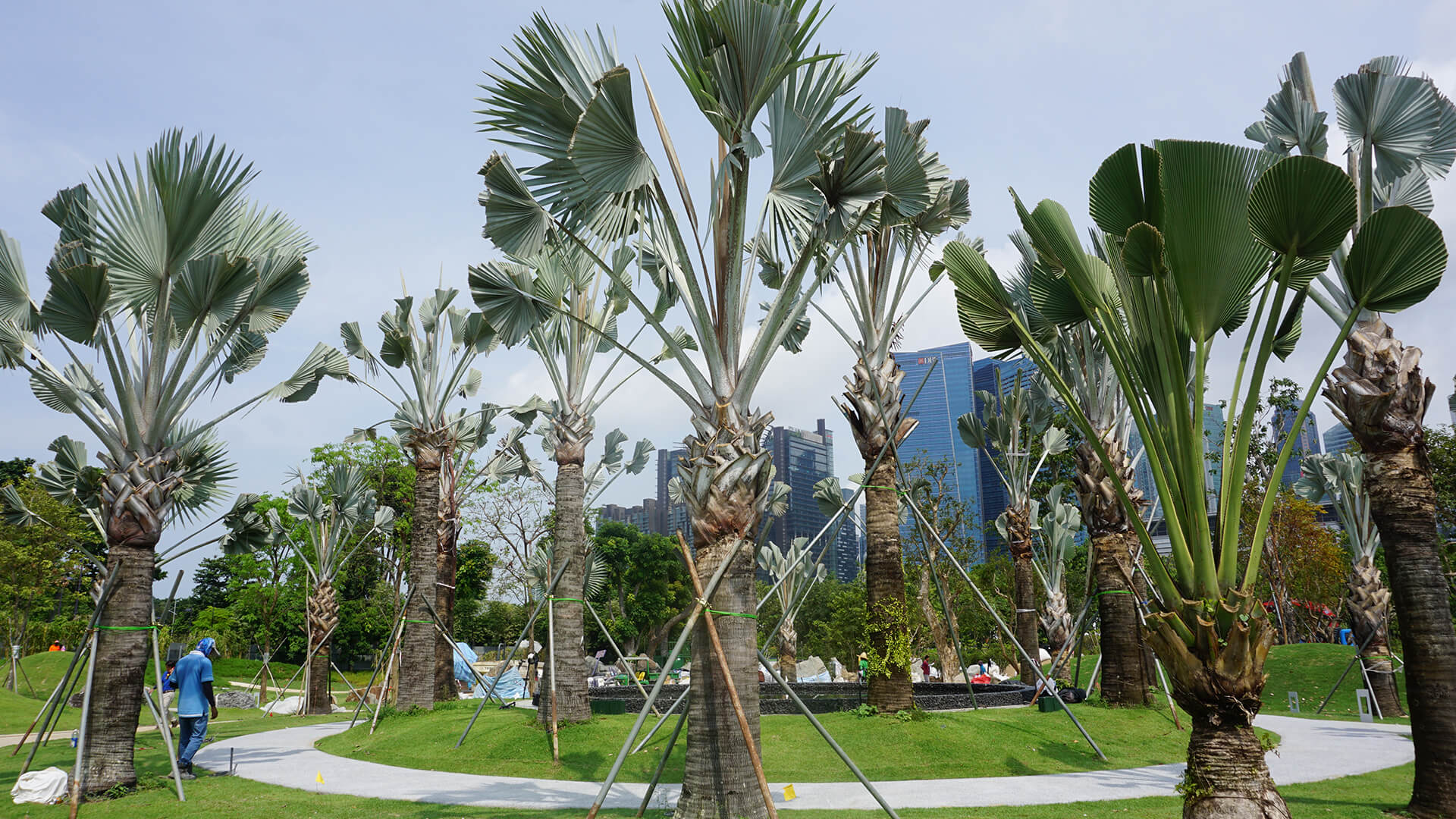
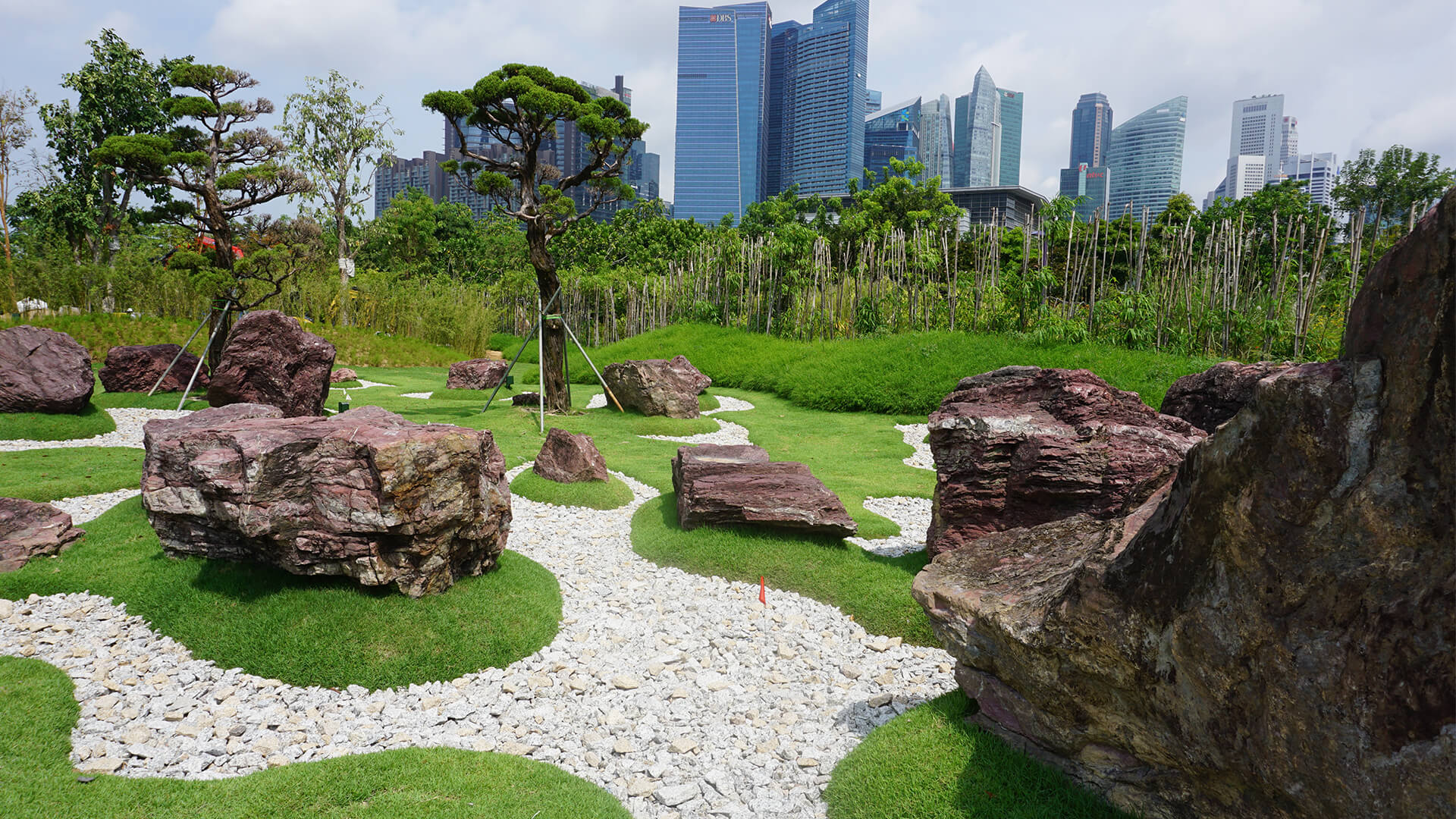

Next




Previous
1
/
4
Next
- Home
- Things to Do
- Attractions
Kingfisher Wetlands
- Attractions
Nature sanctuaryin the heart of the city
For bird watchers and nature lovers, the Kingfisher Wetlands never disappoints. The latest attraction at the Gardens, this new freshwater sanctuary opens your eyes to a flourishing diversity of exotic flora and fauna.
Rarely do you get wetlands like this in the city centre, so seize this opportunity to get up close with Nature. After a fulfilling meal at Satay by the Bay, take an easy stroll to the Wetlands near by. Savour all that nature has to offer, and discover the secrets to biodiversity—thriving right in the heart of our urban world.
Opening Hours
Daily: 5.00am – 2.00am
Admission Rates
Free admission
Tour
For bird watchers and nature lovers, the Kingfisher Wetlands never disappoints. The latest attraction at the Gardens, this new freshwater sanctuary opens your eyes to a flourishing diversity of exotic flora and fauna.
Explore
the Wetlands
The Kingfisher Wetlands, sponsored by Kikkoman is a haven of biodiversity. The water cascades and streamlets at Kingfisher Wetlands create microhabitats for biodiversity to flourish. Over 200 native true mangrove trees and mangrove associates have been planted, contributing to sustainability by storing “blue” carbon.
Ready for more discoveries? Get on the new Wildlife Lookout deck to spot birds, reptiles and other animals bustling all around. Make it a learning adventure for your children too—Kingfisher Wetlands is filled with educational signages that satisfy their curious minds about the birds and animals that frequent the Wetlands.
Organised groups from local institutes of higher learning, community groups, social service agencies and public agencies can sign up for our Nature and Sustainability Tours where guides can bring you on a free walking tour to discover the native biodiversity found here and learn about the role of such urban wetlands in face of climate change!
Size of Kingfisher Wetlands
15,000 sq m
(slightly bigger than the size of two football pitches!)
Number of Zones
3
Habitats for biodiversity
More than 200 mangrove trees and related plants

Zone 1: Natural Rock Pool & Main Cascades

Zone 2A & 2B: Kingfisher Cascades(Meandering cascades linking Kingfisher Lake & Lotus Pond)

Zone 3: Wildlife Lookout
Kingfisher Wetlands Trail

- Celebrate our Biodiversity
- A Living Laboratory
Mangroves
Mangroves are incredibly hardy trees. Mangroves are defined by their common ability to grow submerged in brackish water (water saltier than freshwater, but not as much saltwater). Found on coastlines, they offer critical shelters for hundreds of marine lives. Most amazingly, mangroves are known to be able to sequester four times more carbon than rainforests!
Visiting the mangroves? Try spotting these local mangrove heroes among the varied species.
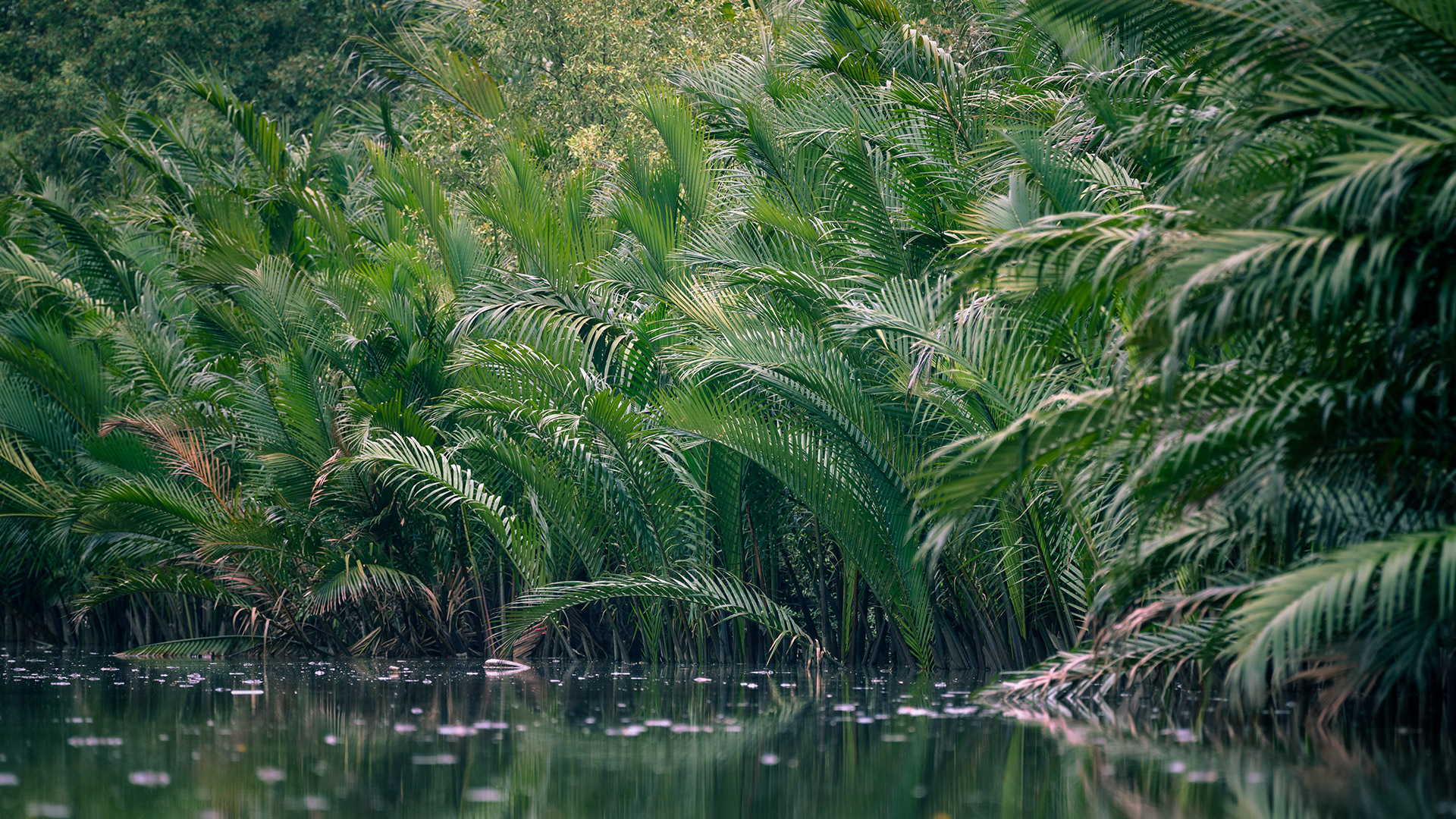 Nipah Palm (Nypa fruticans)
Nipah Palm (Nypa fruticans)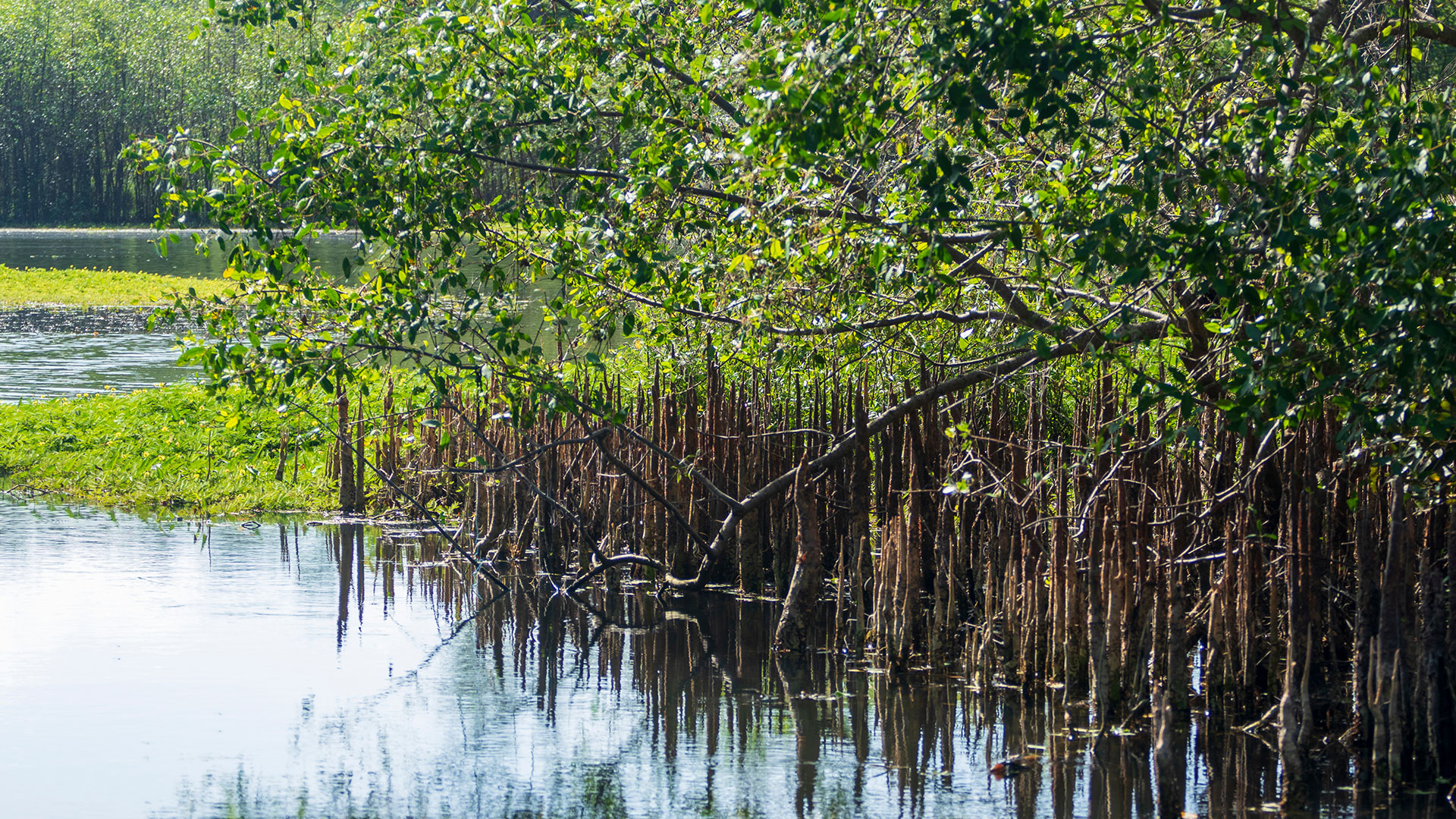 Firefly Mangrove (Sonneratia caseolaris)
Firefly Mangrove (Sonneratia caseolaris)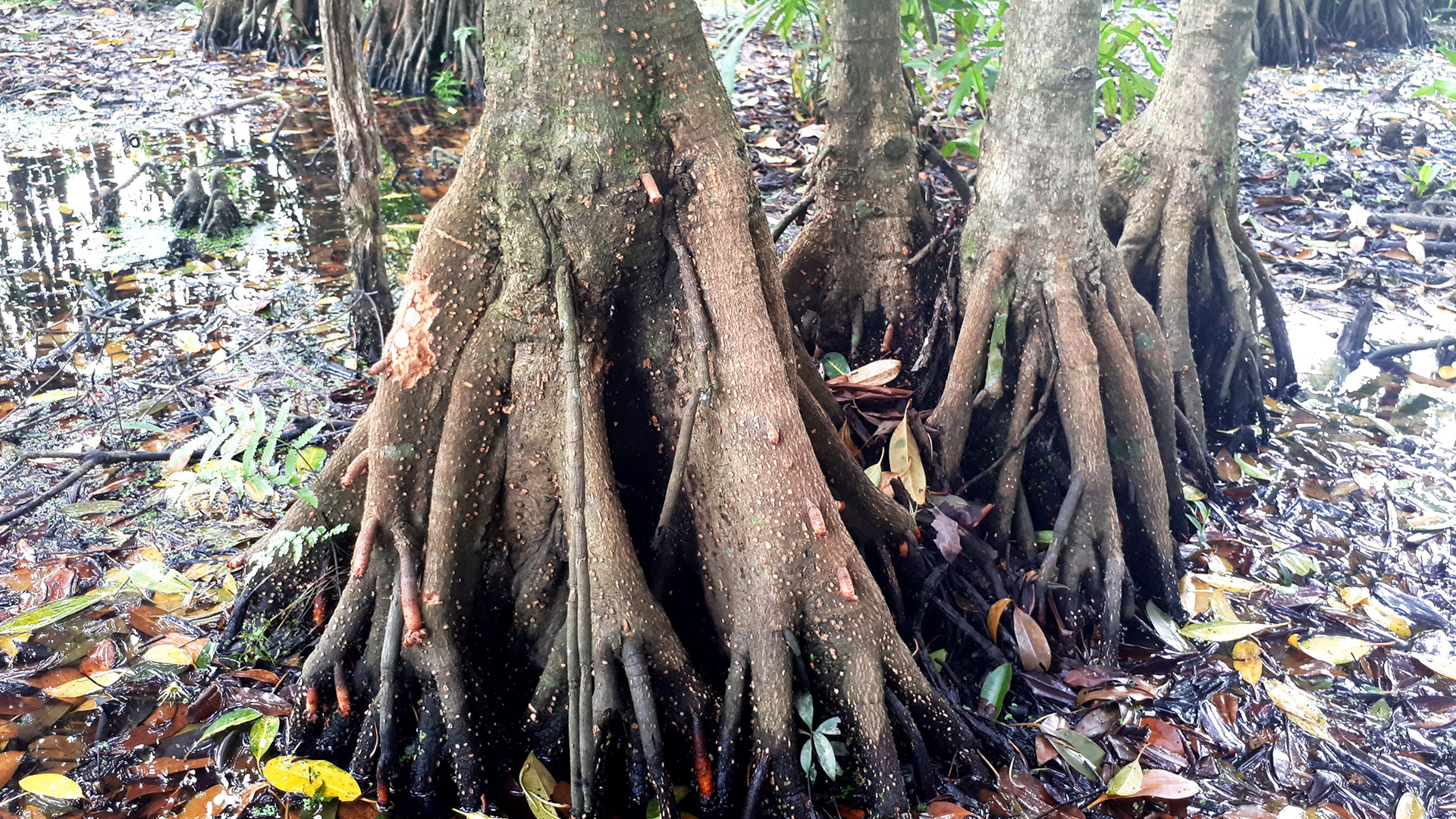 Upriver Orange Mangrove (Bruguiera sexangula)
Upriver Orange Mangrove (Bruguiera sexangula)
Previous



Next



Previous
1
/
3
Next
Nipah Palm (Nypa fruticans)
Status: Vulnerable in Singapore
This is the only fully-adapted mangrove palm! Seemingly trunkless, its leaf bases and branching underground stems are buried and often underwater. Known locally as attap chee, the candied, translucent, immature seeds often top iced desserts!
Firefly Mangrove (Sonneratia caseolaris)
Status: Critically endangered in Singapore
In other regions, mangrove fireflies gather on these trees, synchronising their flashing in a pulsing glow. Their pneumatophores (corky, vertical ‘breathing’ roots) grow above the water, allowing air exchange for the submerged root system.
Upriver Orange Mangrove (Bruguiera sexangula)
Status: Critically endangered in Singapore
The viviparous seeds of this tree sprout while still inside the hanging fruits, eventually falling off the tree to plant itself in the mud below or float off to sprout elsewhere. Multi-branched stilt roots anchor the tree against the current and aerate the root system.
Kingfishers of the Lake and other wildlife
This goes to show just how much migratory birds adore this natural sanctuary. Fans include several of Singapore’s nine Kingfisher species such as the White-collared Kingfisher and Common Kingfisher. On luckier days, you will also catch a glimpse of rarer guests such as the White-breasted Waterhen, Scarlet-backed Flowerpecker, and Lesser Whistling Ducks.
Insects like the Plain Tiger Butterfly and Blue Dasher Dragonfly are frequent visitors too. And for animal lovers, one word of advice: keep your eyes peeled. You never know when the Malayan Water Monitor and Smooth-coated Otter will make their special appearances.
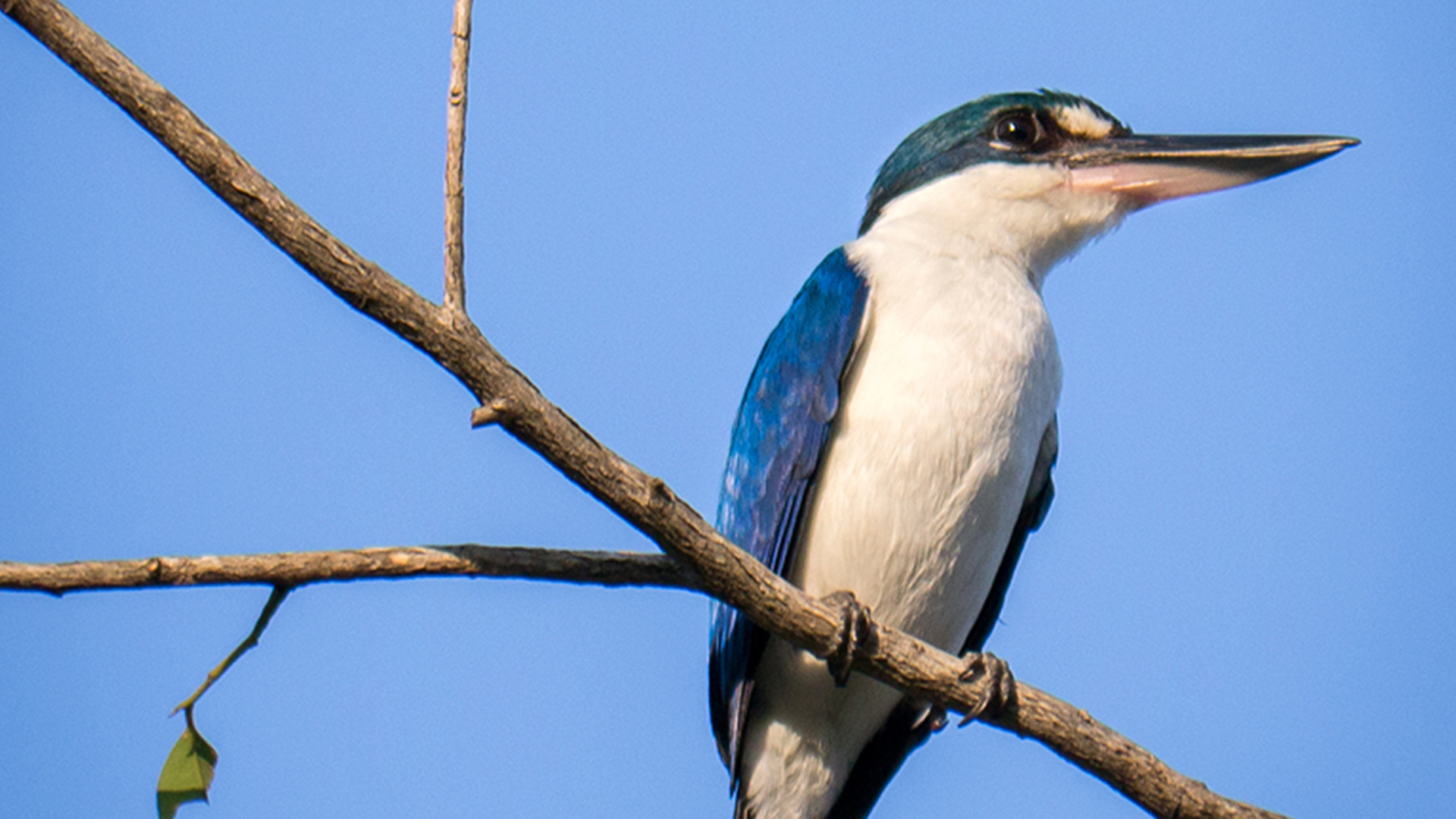 Collared Kingfisher
Collared Kingfisher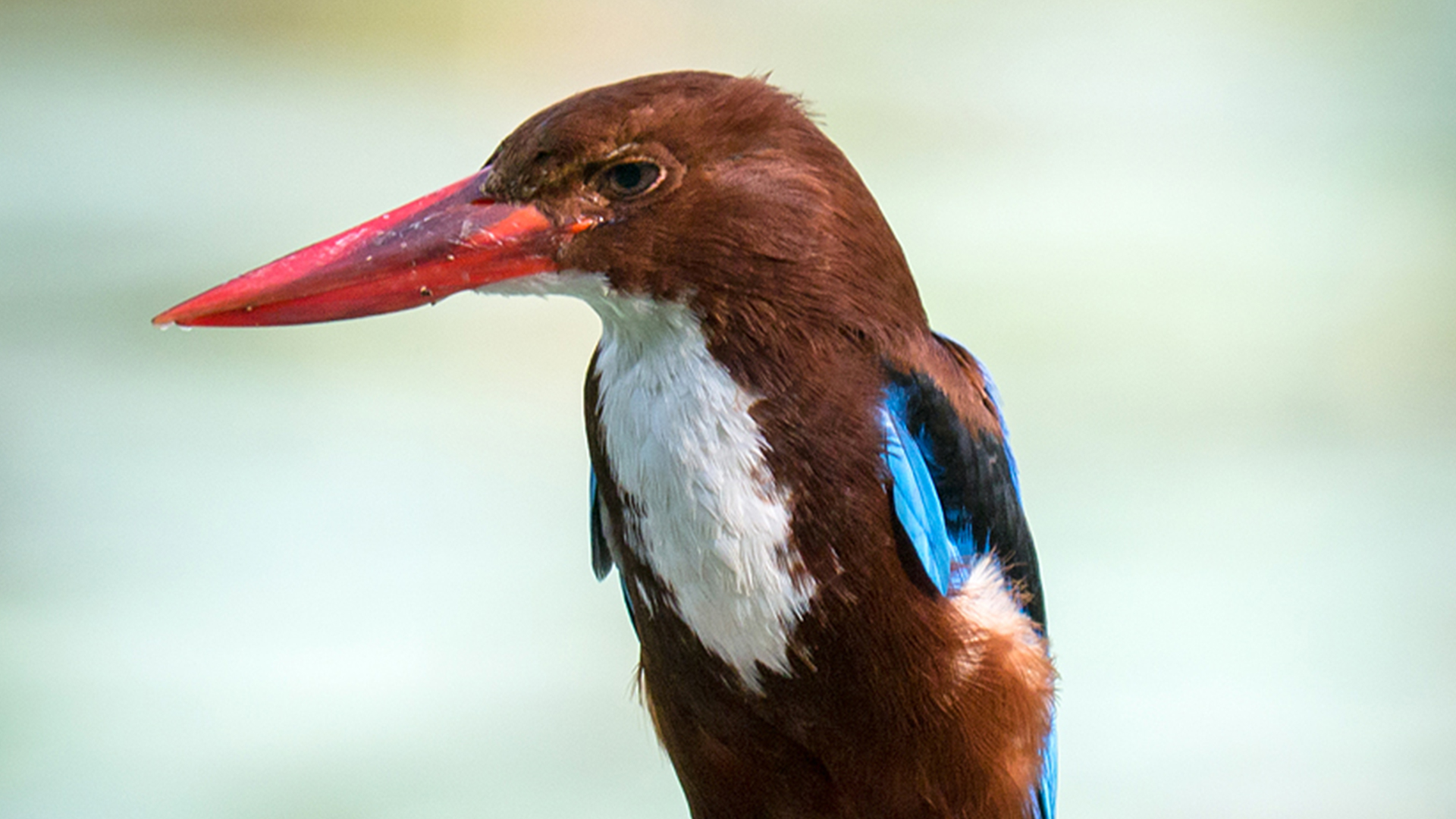 White-throated Kingfisher
White-throated Kingfisher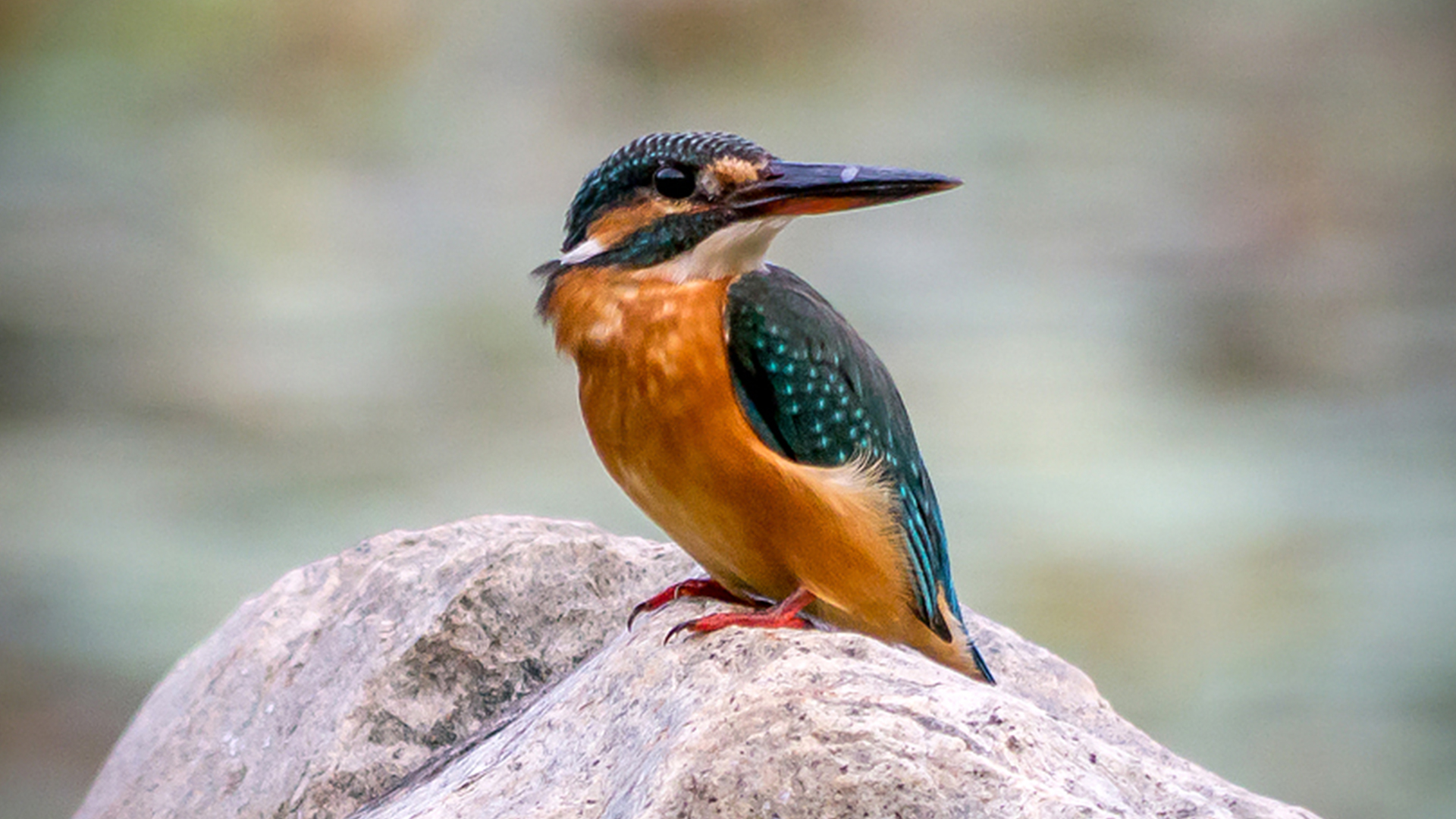 Common Kingfisher
Common Kingfisher
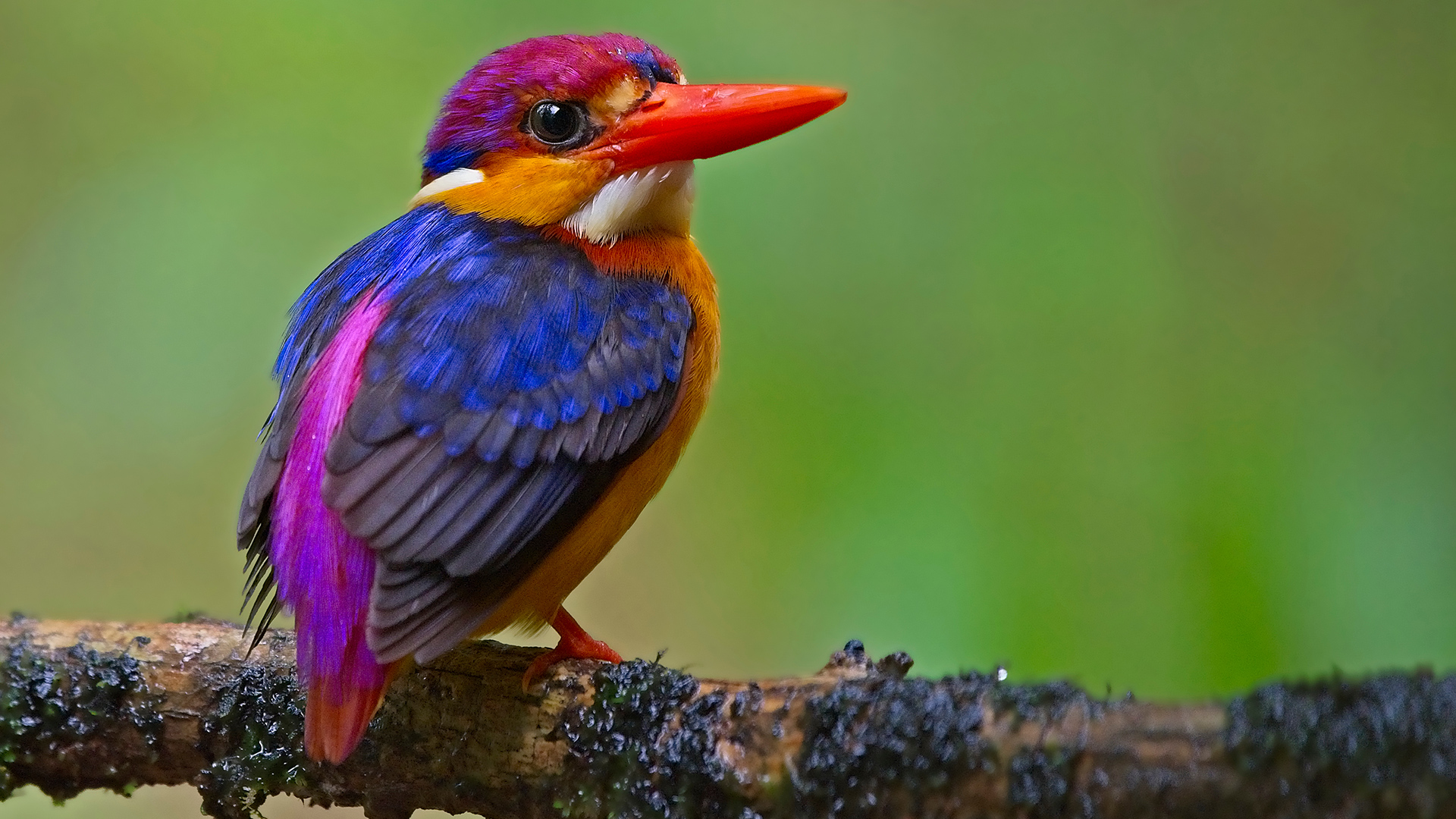 Oriental Dwarf Kingfisher
Oriental Dwarf Kingfisher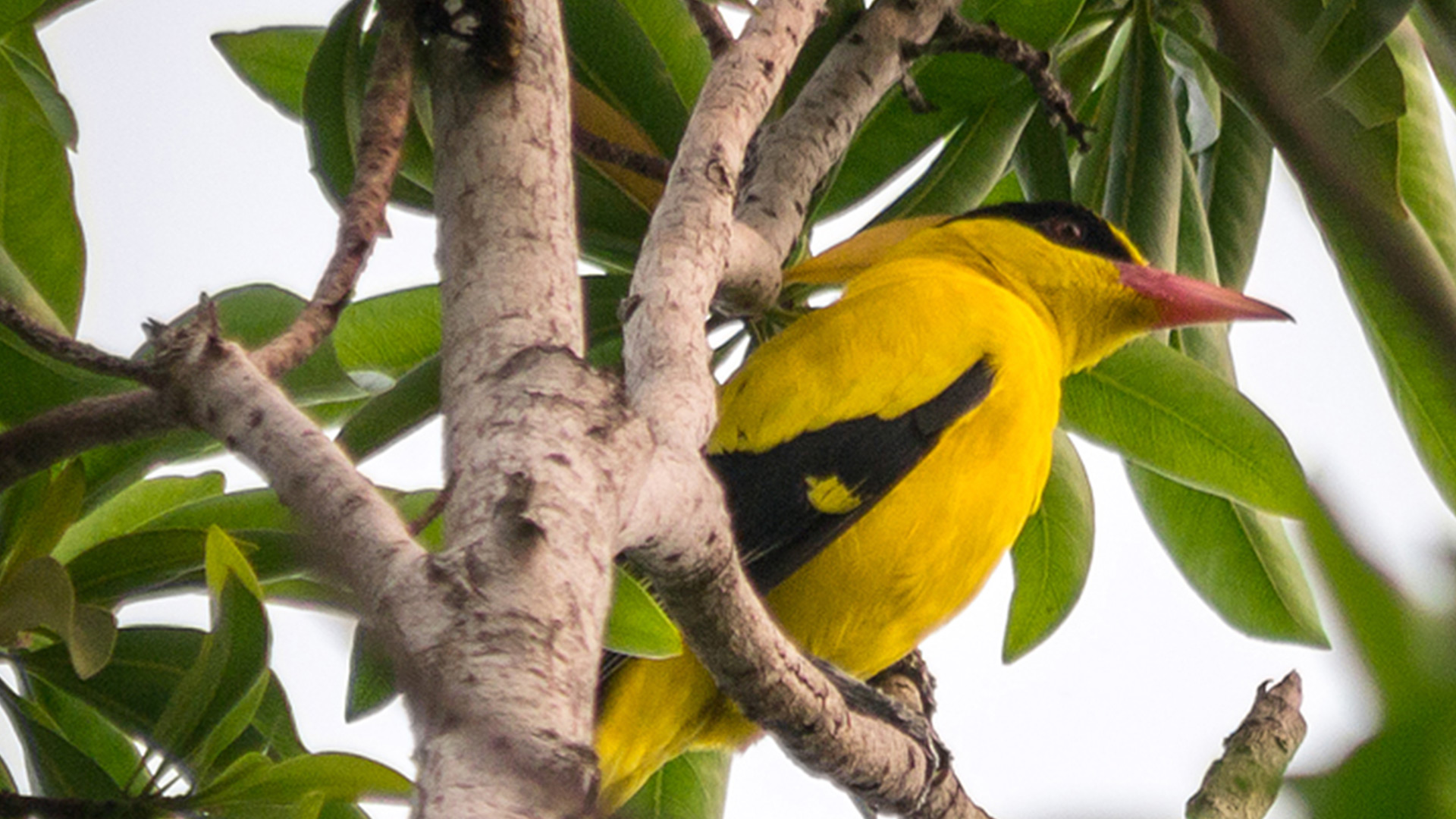 Black-naped Oriole
Black-naped Oriole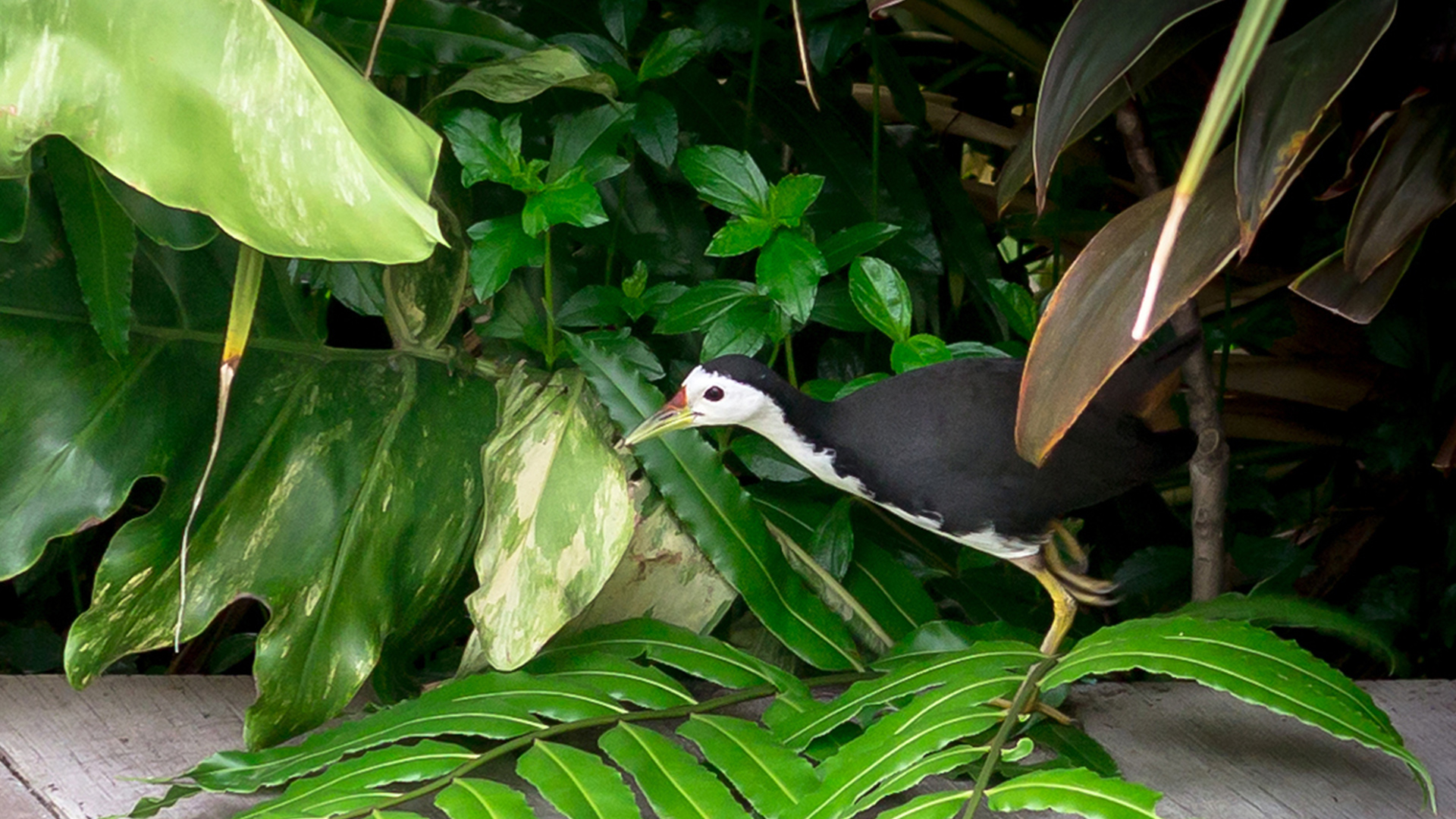 White-breasted Waterhen
White-breasted Waterhen
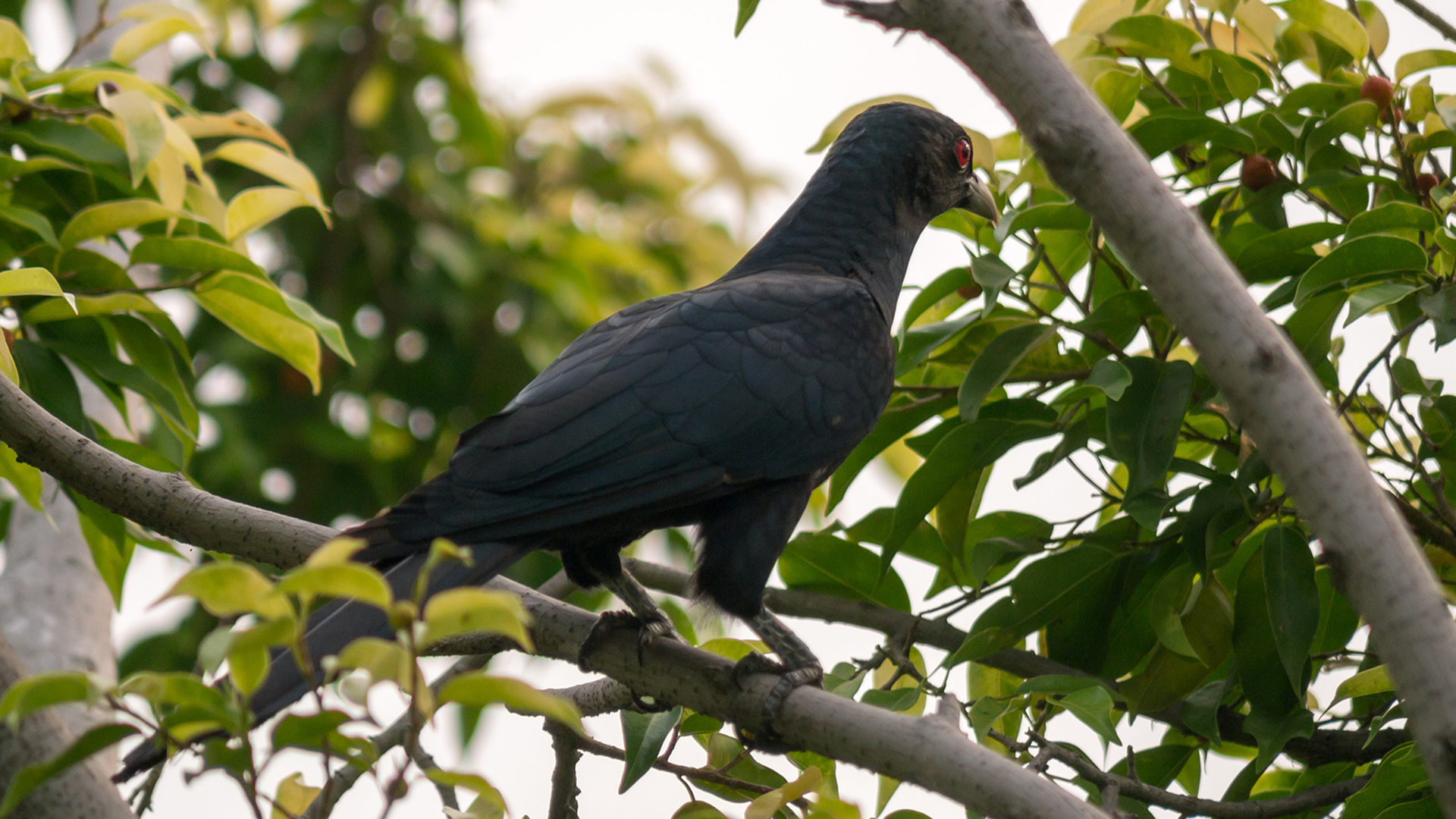 Asian Koel
Asian Koel Malayan Water Monitor
Malayan Water Monitor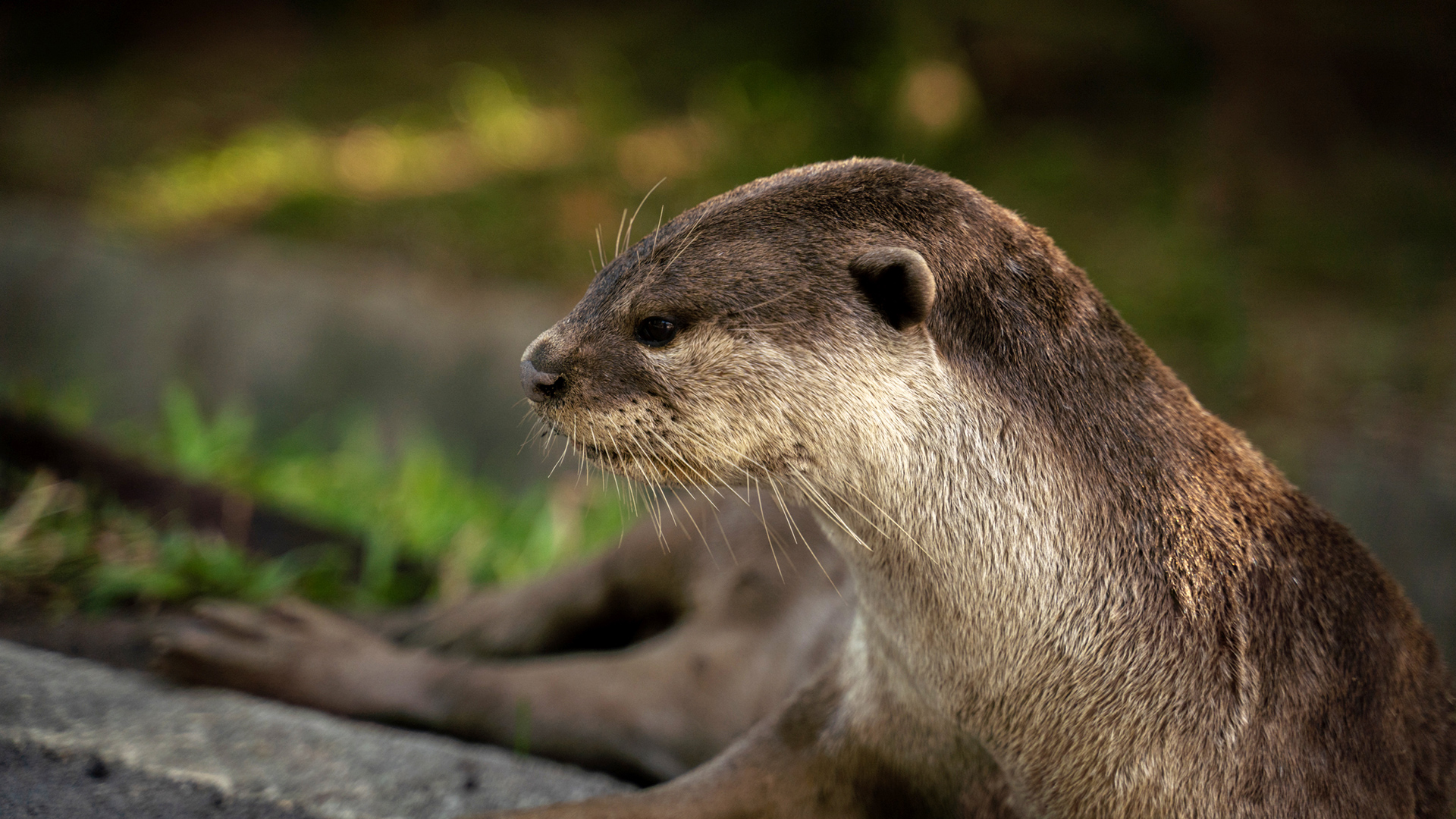 Smooth-coated Otter
Smooth-coated Otter
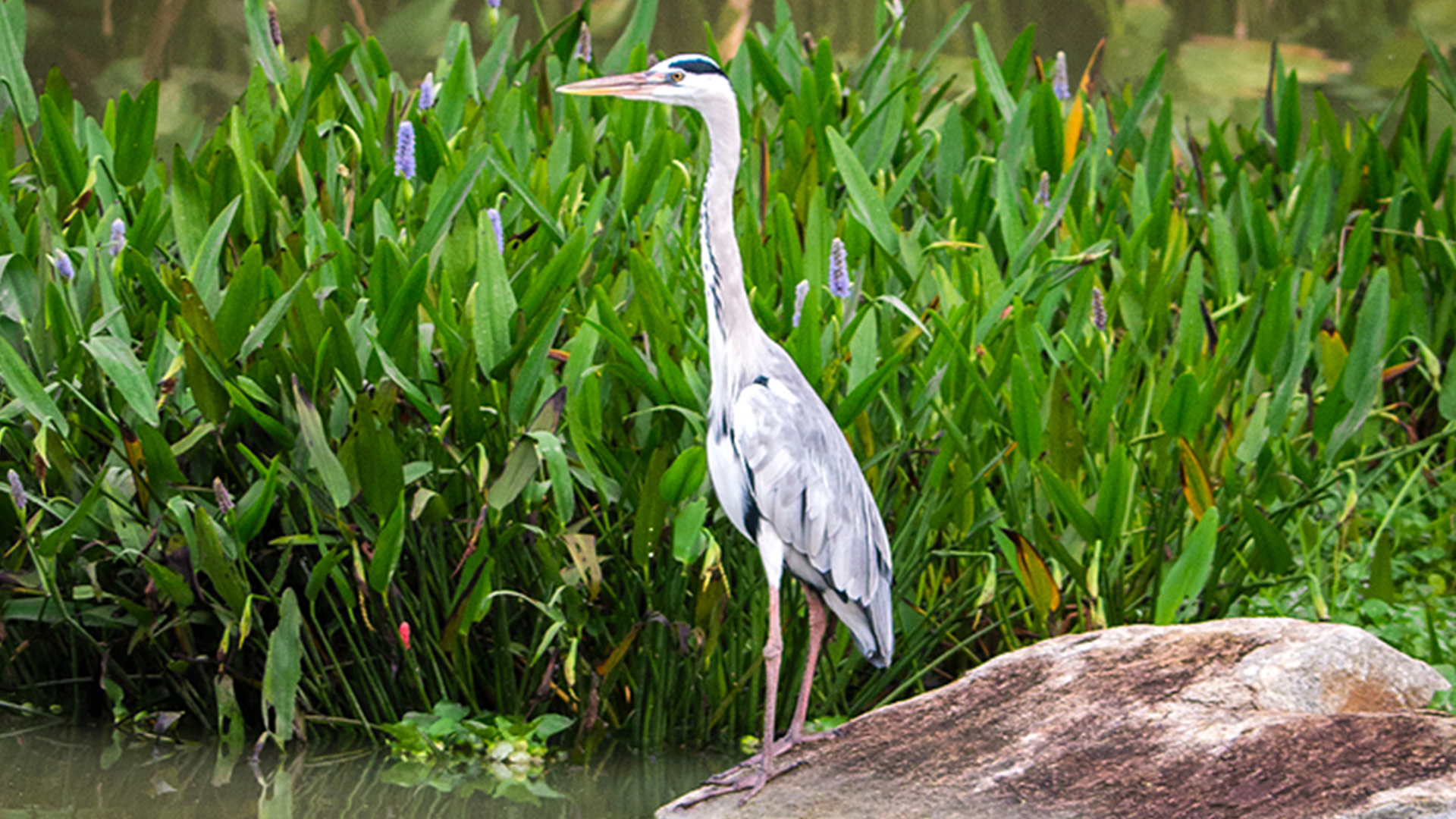 Grey Heron
Grey Heron Blue Dasher Dragonfly
Blue Dasher Dragonfly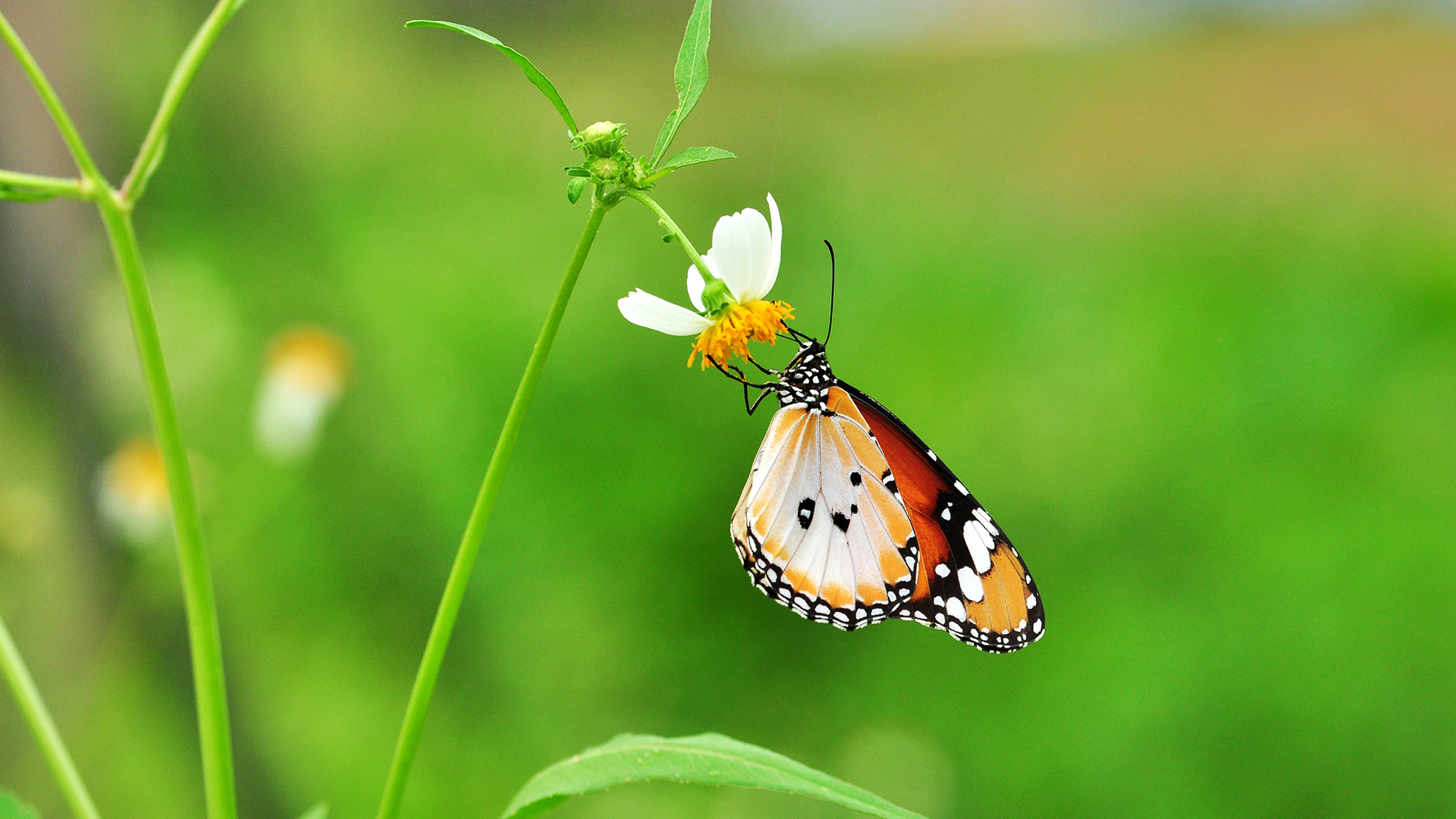 Plain Tiger Butterfly
Plain Tiger Butterfly
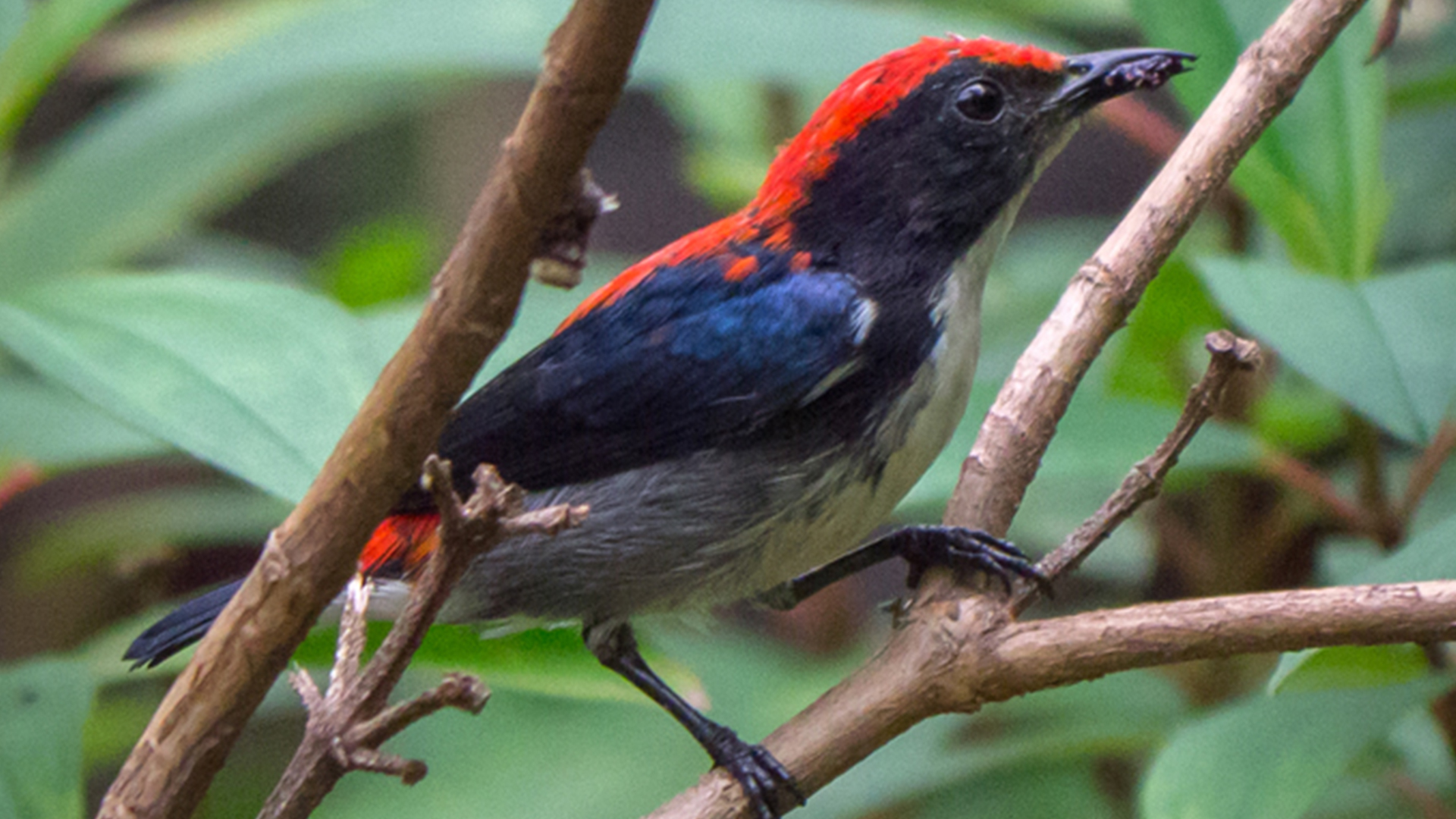 Scarlet-backed Flowerpecker
Scarlet-backed Flowerpecker White-breasted Waterhen
White-breasted Waterhen Yellow Bittern
Yellow Bittern
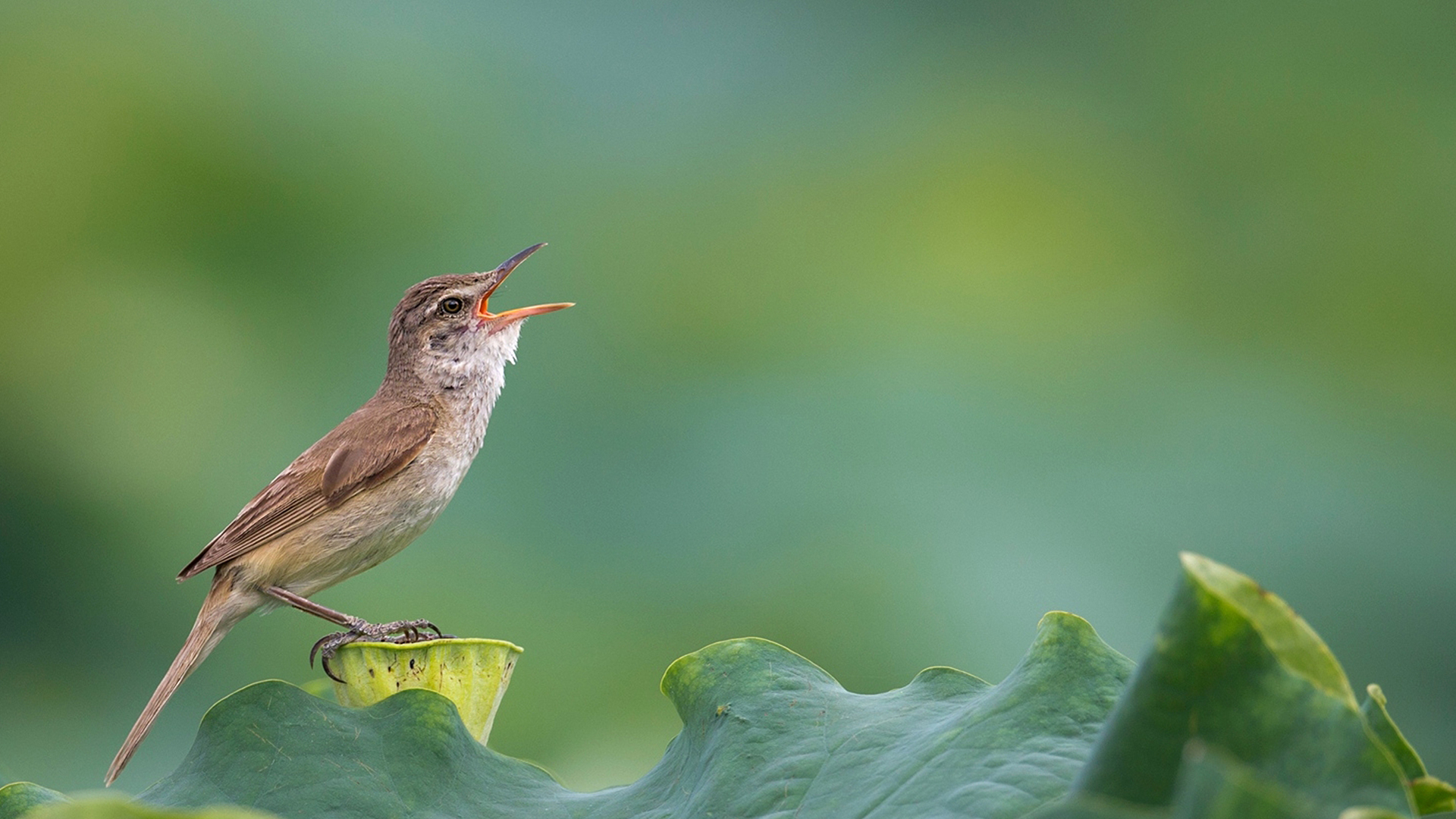 Oriental Reed Warbler
Oriental Reed Warbler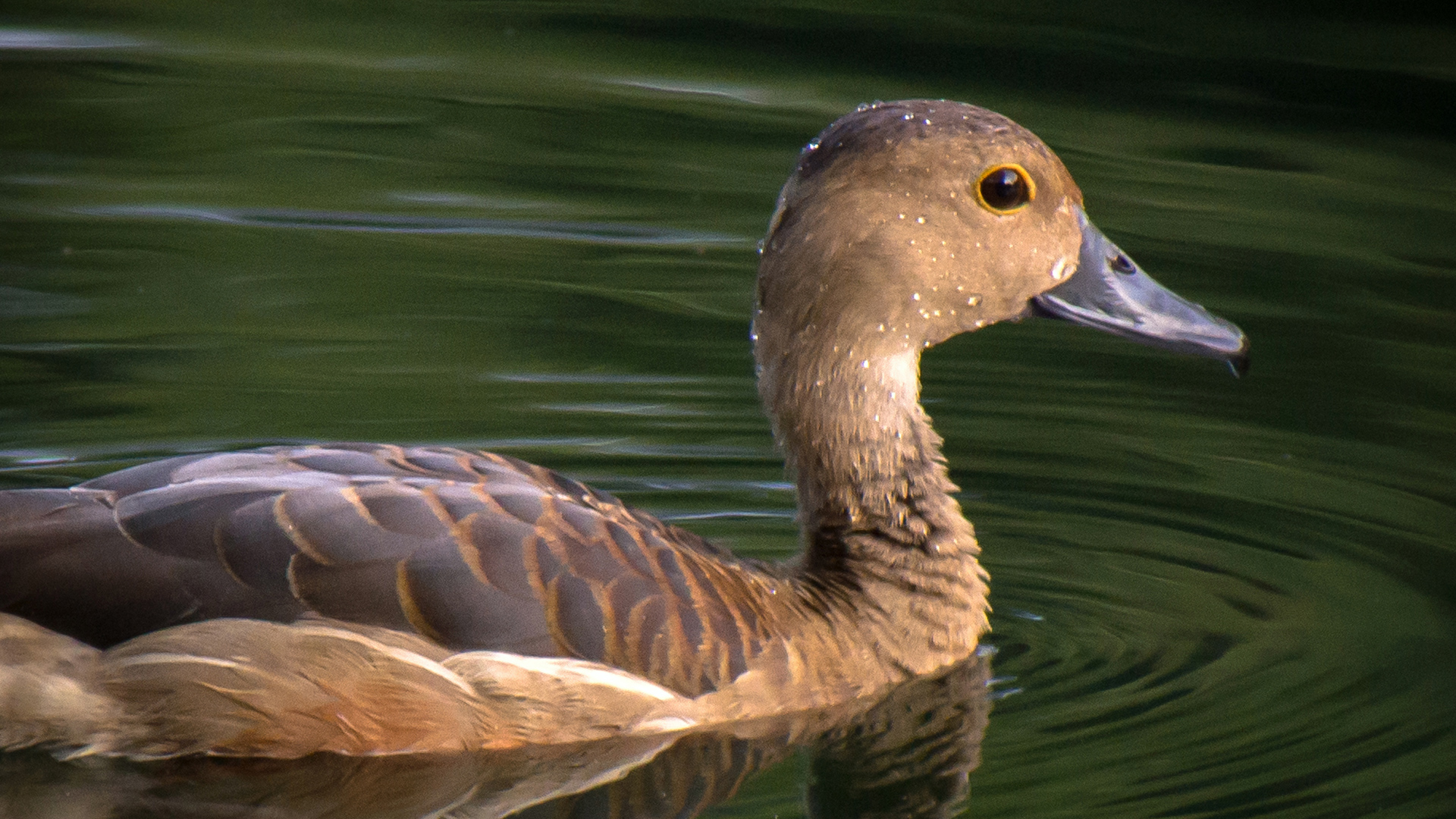 Lesser Whistling Duck
Lesser Whistling Duck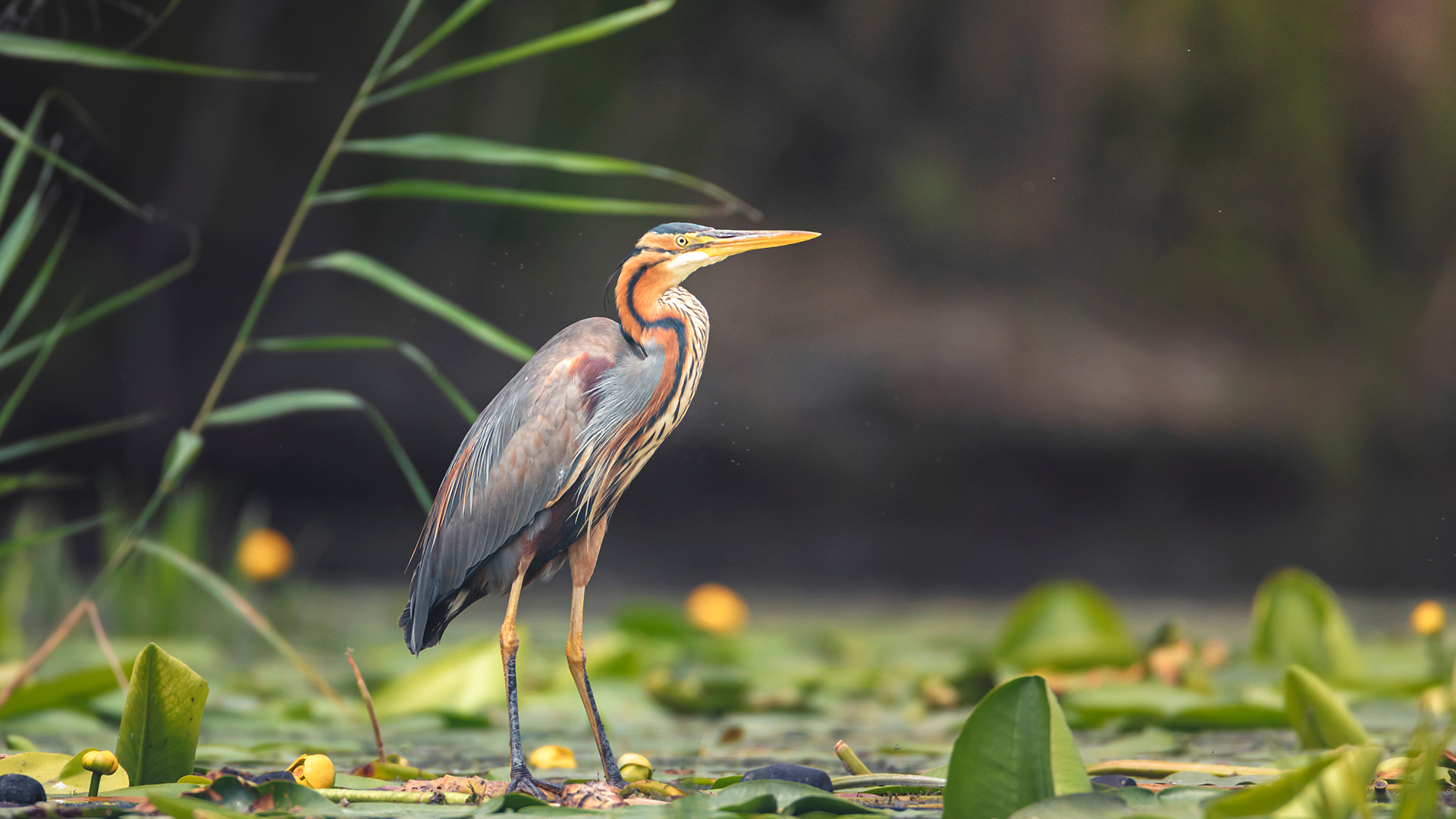 Purple Heron
Purple Heron
 Ruddy-breasted crake
Ruddy-breasted crake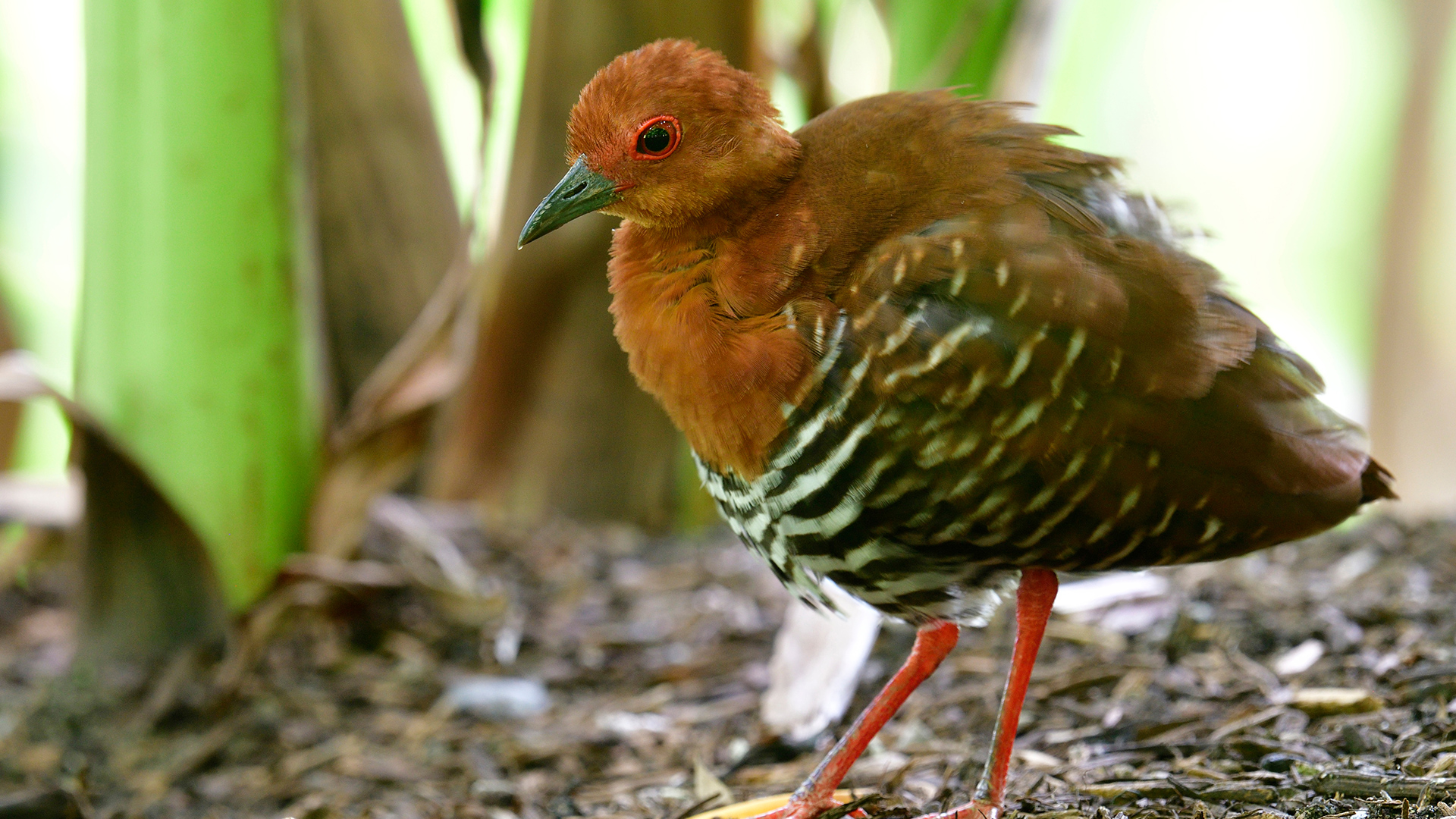 Red-legged crake
Red-legged crake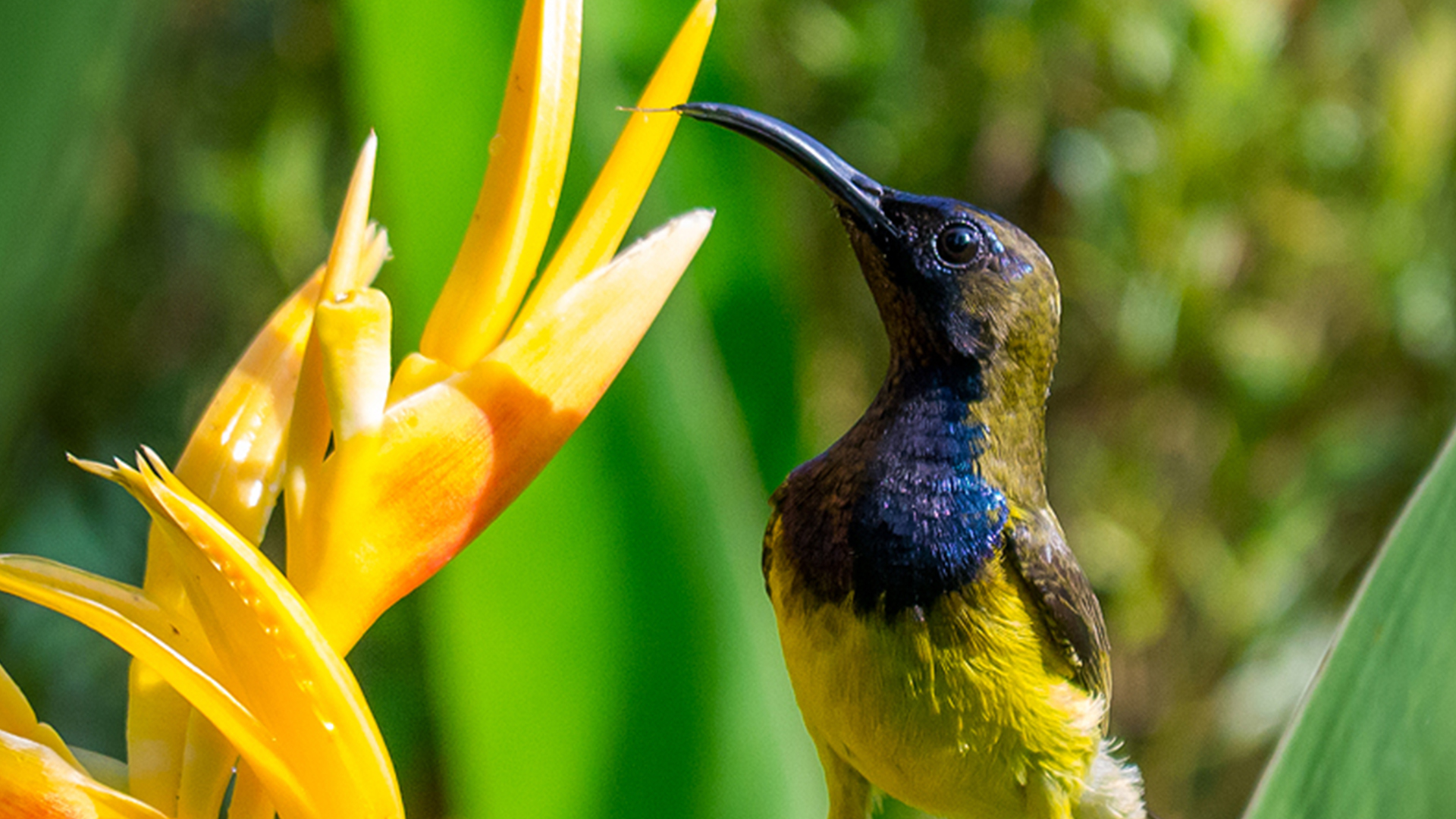 Olive-backed Sunbird
Olive-backed Sunbird
Previous





















Next





















Previous
1
/
21
Next
Collared Kingfisher
The most common kingfisher. It is mostly blue with a white collar and breast. The loud "keek-keek" call of this bird is as head-turning as its bright blue and white plumage!
White-throated Kingfisher
Mostly brown, this kingfisher has a blue back and striking red beak.
Common Kingfisher
Actually an uncommon winter migrant, this bird visits from August to March and has a teal back and reddish-brown breast.
Oriental Dwarf Kingfisher
This tiny rainbow is also fleeting! An uncommon winter visitor from october to March, it's easily recognized by its lilac-red head, yellow breast, and blue-black back.
Black-naped Oriole
With a voice to match its bright yellow and black plumage, this bird calls in melodious fluting whistles like the "ku-eyou-ou" call.
White-breasted Waterhen
Frequently hiding, this shy but chatty bird mutters in throaty chuckles and measured clucks.
Asian Koel
Locals will definitely be familiar with raucous, repeated "ko-el" screams of this bird!
Malayan Water Monitor
This large lizard is the Malayan water monitor (Varanus salvator), a cousin of the Indonesia’s Komodo dragon!
While it has a venomous bite and sharp teeth and claws, this slow, shy lizard likes the easy life, basking in the sun and searching for crabs, fish, and carrion to eat. Monitor lizards usually flee if approached, but feel free to take another route if it refuses to give up its basking spot!
Smooth-coated Otter
Grey Heron
Blue Dasher Dragonfly
Plain Tiger Butterfly
Scarlet-backed Flowerpecker
Common resident breeder
White-breasted Waterhen
Common resident breeder and winter visitor
Yellow Bittern
Common resident breeder and winter visitor
Oriental Reed Warbler
Common winter visitor
Lesser Whistling Duck
Uncommon resident breeder
Purple Heron
Uncommon resident breeder
Ruddy-breasted crake
Uncommon resident breeder and winter visitor
Red-legged crake
Uncommon resident breeder and winter visitor
Olive-backed Sunbird
Testbedding Nature-based Solutions

Supported by Temasek and SG Eco Fund, a one-year pilot study was conducted at Kingfisher Wetlands to explore the potential for urban wetlands to capture carbon. Leveraging Kingfisher Wetlands as a living laboratory, the study identified mangrove species that do well in Gardens by the Bay’s freshwater conditions, and as such, can be planted in man-made wetlands to provide more habitats that are attractive to biodiversity. The results also revealed that carbon content in the sediments of the ponds within Kingfisher Wetlands was higher than natural “blue carbon” ecosystems– likely due to the low environment variability such as tides, currents and inundation frequency. In addition, carbon stock of mangroves at Kingfisher Wetlands increased as the plants grew over the monitoring period. Taken together with the biodiversity it supports, man-made wetlands are a potential nature-based climate solution that can improve the resilience of cities against climate change.
Community Engagement
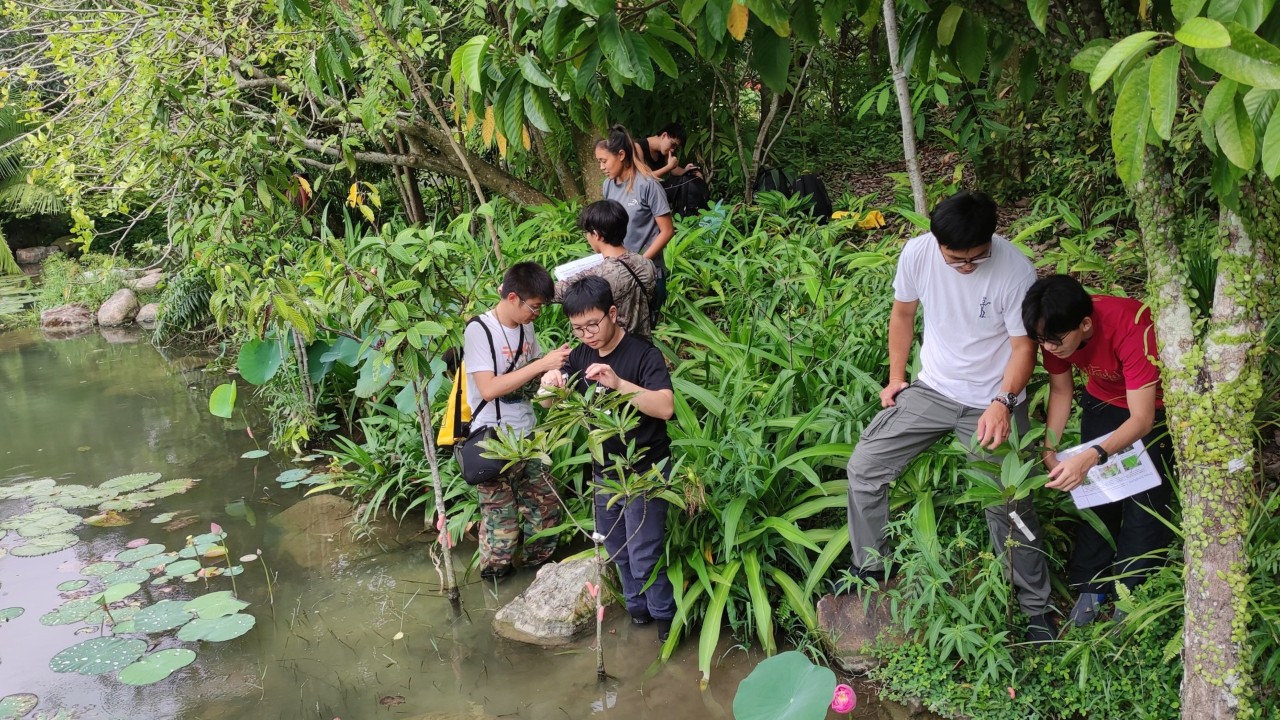
Kingfisher Wetlands is also a platform for community engagement, where the Wonderful Wetlands Series engaged over 850 members of public, including tertiary institutions and corporate groups. Through public lectures and mangrove monitoring sessions, participants learnt about the importance of mangroves and nature-based solutions and citizen scientists helped to collect data on site.
Resources
Check out these slides from the Wonderful Wetlands Series to learn more about mangroves and the study at Kingfisher Wetlands:

World Environment Day 2022: Blue Carbon in Mangroves

Climate Action Week 2022: Mangroves of Singapore

Go Green SG 2023: Lessons from Urban Wetlands – Mangroves in Freshwater and Carbon Sequestration
Celebrate our Biodiversity
Mangroves
Mangroves are incredibly hardy trees. Mangroves are defined by their common ability to grow submerged in brackish water (water saltier than freshwater, but not as much saltwater). Found on coastlines, they offer critical shelters for hundreds of marine lives. Most amazingly, mangroves are known to be able to sequester four times more carbon than rainforests!
Visiting the mangroves? Try spotting these local mangrove heroes among the varied species.
 Nipah Palm (Nypa fruticans)
Nipah Palm (Nypa fruticans) Firefly Mangrove (Sonneratia caseolaris)
Firefly Mangrove (Sonneratia caseolaris) Upriver Orange Mangrove (Bruguiera sexangula)
Upriver Orange Mangrove (Bruguiera sexangula)
Previous



Next



Previous
1
/
3
Next
Nipah Palm (Nypa fruticans)
Status: Vulnerable in Singapore
This is the only fully-adapted mangrove palm! Seemingly trunkless, its leaf bases and branching underground stems are buried and often underwater. Known locally as attap chee, the candied, translucent, immature seeds often top iced desserts!
Firefly Mangrove (Sonneratia caseolaris)
Status: Critically endangered in Singapore
In other regions, mangrove fireflies gather on these trees, synchronising their flashing in a pulsing glow. Their pneumatophores (corky, vertical ‘breathing’ roots) grow above the water, allowing air exchange for the submerged root system.
Upriver Orange Mangrove (Bruguiera sexangula)
Status: Critically endangered in Singapore
The viviparous seeds of this tree sprout while still inside the hanging fruits, eventually falling off the tree to plant itself in the mud below or float off to sprout elsewhere. Multi-branched stilt roots anchor the tree against the current and aerate the root system.
Kingfishers of the Lake and other wildlife
This goes to show just how much migratory birds adore this natural sanctuary. Fans include several of Singapore’s nine Kingfisher species such as the White-collared Kingfisher and Common Kingfisher. On luckier days, you will also catch a glimpse of rarer guests such as the White-breasted Waterhen, Scarlet-backed Flowerpecker, and Lesser Whistling Ducks.
Insects like the Plain Tiger Butterfly and Blue Dasher Dragonfly are frequent visitors too. And for animal lovers, one word of advice: keep your eyes peeled. You never know when the Malayan Water Monitor and Smooth-coated Otter will make their special appearances.
 Collared Kingfisher
Collared Kingfisher White-throated Kingfisher
White-throated Kingfisher Common Kingfisher
Common Kingfisher
 Oriental Dwarf Kingfisher
Oriental Dwarf Kingfisher Black-naped Oriole
Black-naped Oriole White-breasted Waterhen
White-breasted Waterhen
 Asian Koel
Asian Koel Malayan Water Monitor
Malayan Water Monitor Smooth-coated Otter
Smooth-coated Otter
 Grey Heron
Grey Heron Blue Dasher Dragonfly
Blue Dasher Dragonfly Plain Tiger Butterfly
Plain Tiger Butterfly
 Scarlet-backed Flowerpecker
Scarlet-backed Flowerpecker White-breasted Waterhen
White-breasted Waterhen Yellow Bittern
Yellow Bittern
 Oriental Reed Warbler
Oriental Reed Warbler Lesser Whistling Duck
Lesser Whistling Duck Purple Heron
Purple Heron
 Ruddy-breasted crake
Ruddy-breasted crake Red-legged crake
Red-legged crake Olive-backed Sunbird
Olive-backed Sunbird
Previous





















Next





















Previous
1
/
21
Next
Collared Kingfisher
The most common kingfisher. It is mostly blue with a white collar and breast. The loud "keek-keek" call of this bird is as head-turning as its bright blue and white plumage!
White-throated Kingfisher
Mostly brown, this kingfisher has a blue back and striking red beak.
Common Kingfisher
Actually an uncommon winter migrant, this bird visits from August to March and has a teal back and reddish-brown breast.
Oriental Dwarf Kingfisher
This tiny rainbow is also fleeting! An uncommon winter visitor from october to March, it's easily recognized by its lilac-red head, yellow breast, and blue-black back.
Black-naped Oriole
With a voice to match its bright yellow and black plumage, this bird calls in melodious fluting whistles like the "ku-eyou-ou" call.
White-breasted Waterhen
Frequently hiding, this shy but chatty bird mutters in throaty chuckles and measured clucks.
Asian Koel
Locals will definitely be familiar with raucous, repeated "ko-el" screams of this bird!
Malayan Water Monitor
This large lizard is the Malayan water monitor (Varanus salvator), a cousin of the Indonesia’s Komodo dragon!
While it has a venomous bite and sharp teeth and claws, this slow, shy lizard likes the easy life, basking in the sun and searching for crabs, fish, and carrion to eat. Monitor lizards usually flee if approached, but feel free to take another route if it refuses to give up its basking spot!
Smooth-coated Otter
Grey Heron
Blue Dasher Dragonfly
Plain Tiger Butterfly
Scarlet-backed Flowerpecker
Common resident breeder
White-breasted Waterhen
Common resident breeder and winter visitor
Yellow Bittern
Common resident breeder and winter visitor
Oriental Reed Warbler
Common winter visitor
Lesser Whistling Duck
Uncommon resident breeder
Purple Heron
Uncommon resident breeder
Ruddy-breasted crake
Uncommon resident breeder and winter visitor
Red-legged crake
Uncommon resident breeder and winter visitor
Olive-backed Sunbird
A Living Laboratory
Testbedding Nature-based Solutions

Supported by Temasek and SG Eco Fund, a one-year pilot study was conducted at Kingfisher Wetlands to explore the potential for urban wetlands to capture carbon. Leveraging Kingfisher Wetlands as a living laboratory, the study identified mangrove species that do well in Gardens by the Bay’s freshwater conditions, and as such, can be planted in man-made wetlands to provide more habitats that are attractive to biodiversity. The results also revealed that carbon content in the sediments of the ponds within Kingfisher Wetlands was higher than natural “blue carbon” ecosystems– likely due to the low environment variability such as tides, currents and inundation frequency. In addition, carbon stock of mangroves at Kingfisher Wetlands increased as the plants grew over the monitoring period. Taken together with the biodiversity it supports, man-made wetlands are a potential nature-based climate solution that can improve the resilience of cities against climate change.
Community Engagement

Kingfisher Wetlands is also a platform for community engagement, where the Wonderful Wetlands Series engaged over 850 members of public, including tertiary institutions and corporate groups. Through public lectures and mangrove monitoring sessions, participants learnt about the importance of mangroves and nature-based solutions and citizen scientists helped to collect data on site.
Resources
Check out these slides from the Wonderful Wetlands Series to learn more about mangroves and the study at Kingfisher Wetlands:

World Environment Day 2022: Blue Carbon in Mangroves

Climate Action Week 2022: Mangroves of Singapore

Go Green SG 2023: Lessons from Urban Wetlands – Mangroves in Freshwater and Carbon Sequestration
Check out these events
Discover more at theGardens
###### Active Garden and PropNex Family Zone 
Sign up for our newsletter to stay abreast of happenings in the Gardens!
Connect with Us
- gbb-facebook
- gbb-instagram
- gbb-twitter
- gbb-youtube
- gbb-telegram
- gbb-linkedin
- gbb-weibo
- gbb-wechat
- gbb-tiktok
- gbb-xiaohongshu
18 Marina Gardens Drive, Singapore 018953

Back To Top
We use cookies to gather information and improve your online experience. By accessing and using our website, you agree to this use of cookies. For further details, refer to ourPrivacy Policy

 Gardens by the Bay
Gardens by the Bay
 ###### Rejang Beuh Dance Experience a cultural highlight of the Rejang Beuh Dance, also known as the Eagle Dance in the Flower Dome. Sat, 30 Aug 2025 2.00pm - 2.05pm Mediterranean Garden, Flower Dome
###### Rejang Beuh Dance Experience a cultural highlight of the Rejang Beuh Dance, also known as the Eagle Dance in the Flower Dome. Sat, 30 Aug 2025 2.00pm - 2.05pm Mediterranean Garden, Flower Dome ###### Get Crafty! – Pressed Floral Art Notebook by When Stars Align Unleash your kids’ creative side this September school holidays to craft their very own mini A6 notebook using real pressed flowers. Thu, 11 Sep 2025 Fri, 12 Sep 2025 10.00am - 6.00pm Australian Garden, Flower Dome
###### Get Crafty! – Pressed Floral Art Notebook by When Stars Align Unleash your kids’ creative side this September school holidays to craft their very own mini A6 notebook using real pressed flowers. Thu, 11 Sep 2025 Fri, 12 Sep 2025 10.00am - 6.00pm Australian Garden, Flower Dome ###### Garden Rhapsody Come and be dazzled by the magnificent sight of our Supertrees and let the music and lights entertain you at night! Daily 7.45pm & 8.45pm Supertree Grove
###### Garden Rhapsody Come and be dazzled by the magnificent sight of our Supertrees and let the music and lights entertain you at night! Daily 7.45pm & 8.45pm Supertree Grove

